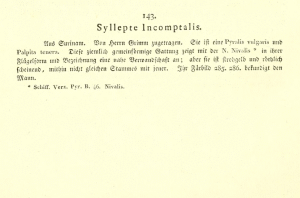1. Diagnose
1.1. Erstbeschreibung
2. Weitere Informationen
2.1. Etymologie (Namenserklärung)
Hübner verzichtete in seinem „Verzeichniß bekannter Schmettlinge“ auf explizite Angaben zur Etymologie.
(Autor: Jürgen Rodeland)
2.2. Taxonomie
Hübner (1823: 18) beschrieb "Syllepte Incomptalis" aus Surinam. Damit wurde "Syllepte" zur per Monotypie beschriebenen Gattung mit Syllepte incomptalis als Typusart.
Solis et al. (2023: 343) schreiben in ihrer Einführung zur Gattungsrevision: "Syllepte Hübner, 1819–21 is one of the largest genera of Pyraloidea with 196 species worldwide (Nuss et al. 2003–2023) and is widely known by pyraloid workers to be a polyphyletic genus, mostly because the included species have never been subjected to a morphological or molecular analysis, and historically many have never even had their genitalia dissected for a comparative study. The second major reason this genus has not been studied is because the Hübner type specimen of the type species, Syllepte incomptalis Hübner, 1819–21 is presumed to be lost and known only from nineteenth century paintings."
2.3. Typenmaterial
Solis et al. (2023: 345) legen für Syllepte incomptalis einen Neotypus fest und definieren die Gattung Syllepte erstmals konkret: "Below, we follow the regulations in the ICZN, Fourth Edition (1999) to designate a neotype for Syllepte incomptalis Hübner, 1819–21. We designate a neotype because there is “exceptional need” for progress in the definition and inclusion of species in Syllepte, currently a polyphyletic taxon which includes species from around the world (Mally et al. 2019) (ICZN 75.3.1), and to stabilize the nomenclature of species currently associated with this genus. We provide a description and diagnosis with morphological characters for Syllepte and how it is differentiated from other taxa (ICZN 75.3.2 and 75.3.3). Type material of Syllepte incomptalis Hübner, 1823 was deposited in the Naturhistorisches Museum Vienna (NHMW) (Groll 2017), where it and numerous other collection items were lost in the Hofburg fire during October 1848 (Horn et al. 1990); recently, Sabine Gaal-Haszler (pers. comm.), Lepidoptera curator at the NHMW, could not find any type material of S. incomptalis (ICZN 75.3.4). We provide evidence that the neotype is consistent with what is known of the former name-bearing type based on comparison of characters below, such as maculation and size, with Hübner’s illustration of S. incomptalis (ICZN 75.3.5). The original type locality is believed to have been from Suriname, and we and our colleagues were unable to locate material from Suriname resembling S. incomptalis in the MTD, MfN, MIZA, NCB, NMNH, NHMUK, NZCS, or ZSM, so we chose geographically close specimens from the tropical Western Hemisphere (ICZN 75.3.6). And finally, we state that the neotype will be deposited in the NMNH, SI, Washington, D.C. (ICZN 75.3.7)." Zum festgelegten Neotypus heißt es dann konkret: "Male. Costa Rica: Alajuela, Area de Conservación Guanacaste, Sector San Cristobal, Sendero Vivero, 10.86739, -85.38744, elev. 730 m., Larva on Malvaviscus palmanus 03/15/2006, ecl. 04/01/2006, Gloria Sihezar, collector, 06-SRNP-2089. COI Barcoded. [USNMENT01899038]. Forewing length: 10 mm. Deposited in the NMNH, SI, Washington, D.C."
Zur Gattung heißt es dann S. 346: "Syllepte Hübner, 1819–1821. Type species: S. incomptalis Hübner, 1819–1821: pl. 50 figs. 285–286; 1823: 18 (dated after Hemming 1937). Synonym: Neomabra Dognin, 1905, rev. stat."
Jetzt müssen noch 200 Arten, die derzeit noch in dieser Gattung stecken, auf ihre tatsächliche Gattungszugehörigkeit hin überprüft werden.
(Autor: Erwin Rennwald)
2.4. Literatur
- Erstbeschreibung: Hübner, J. (1823): Zuträge zur Sammlung exotischer Schmettlinge [sic], bestehend in Bekundigung einzelner Fliegmuster neuer oder rarer nichteuropäischer Gattungen. Zweytes Hundert: 1-32, 8 unpaginierte Seiten, pl. [36]-[69]. Augsburg.
- Solis, M.A., Mally, R., Hayden, J.E. & M. Nuss (2023): Revision of the type species of Syllepte Hübner and other spilomeline genera recently synonymized (Lepidoptera: Crambidae). — Zootaxa, 5389 (3): 343–361.


